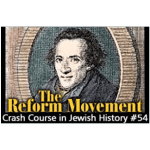History Crash Course #56: The Pale of Settlement
The Napoleonic Enlightenment, which emancipated the Jews of Western Europe, did not make it to Eastern Europe where most Jews lived in the 18th-19th centuries.
The largest concentration of Jews ― about 5 million ― was located there, representing 40% of the Jewish population worldwide.
From 1791 until 1915, the majority of Jews living in Eastern Europe were confined by the Czars of Russia ― starting with Catherine the Great ― to an area known as the “Pale of Settlement” (meaning “borders of settlement”). The Pale consisted of 25 provinces that included Ukraine, Lithuania, Belorussia, Crimea, and part of Poland (which had been partitioned between Russia, Prussia, and Austria in 1772).
The western side of what had formally been Poland was absorbed into the Austro-Hungarian Empire. This western half of Poland (which contained important Jewish communities such as those located in Galicia) contained a smaller, but not insignificant, number of Jews. The physical and economic situation of these Jews of the eastern Austro-Hungarian Empire was generally much better than their fellow Jews living in western end of Czarist Russia.
The Jews of Russia were specifically expelled from Moscow and St. Petersburg and forced into the Pale. Later they were also expelled from rural areas within the Pale and forced to live only in shtetls.
Despite the oppression some amazing things happened in the Pale.
For one thing, charity ― tzedakah, which in Hebrew means “justice” ― thrived, as Jews helped each other. The historian Martin Gilbert writes in his Atlas of Jewish History that no province in the Pale had less than 14% of Jews on relief, and Lithuanian and Ukrainian Jews supported as much as 22% of their poor population:
“Among the charitable societies organized by Jews were those to supply poor students with clothes, soldiers with kosher food, the poor with free medical treatment, poor brides with dowries, and orphans with technical education.”
This was an incredibly sophisticated social welfare system. In times of great hardship, no Jew was abandoned.
This caring for each other did not escape the notice of non-Jews.
In fact, as far back as the Middle Ages Rabbis had instituted takanot (rabbinic enactments) which forbade conversion to Judaism.[1]Israel Abrahams, Jewish Life in the Middle Ages, (Atheneum, 1969), p 59. The primary fear was that there would be an anti-Semitic backlash against the Jews for “stealing” a Christian from his faith, but there was also another reason. Why would a Christian want to convert to Judaism-which could possibly lead to arrest and execution? They realized that no Jew ever starved to death in the street, whereas if you were a Christian peasant you could easily starve to death in the street because no one was going to take care of you. The government wasn’t going to do it and the Church wasn’t going to do it. Even though the Jewish community gave charity to their Gentile neighbors the rabbis didn’t want Judaism being flooded by insincere converts who were trying to save their lives by becoming Jews and benefiting from the Jewish social welfare system.
Torah Learning
Another amazing thing that happened in the Pale, despite the oppression, was the creation of the modern Yeshiva (school for Torah study).
Torah studies (as we saw in Part 52) was a “luxury” largely not available to the masses of Eastern European Jewry in the 18th century and had become a preserve of the elite.
In 1803, Rabbi Chaim ben Isaac of Volozhin (1749-1821), a student of the Vilna Ga’on, set about to revolutionize the concept of the Yeshiva. Most yeshivas during this period were small institutions of learning supported by individual towns in which they were based. Rabbi Chaim proposed to found a large institution, for the top students, and supported by many communities.
He sent letters to the chief rabbis of cities throughout Europe asking them to send to him their best students to study at his yeshiva in Volozhin, Lithuania, (which was later named Etz Chaim ― “Tree of Life” ― in honor of its founder) where he promised to provide them with financial support, top teachers, and a high-level standardized curriculum. The response to his letter was very positive and a large number of students were sent to the Volozhin Yeshiva, which eventually enrolled 450 students.
Unfortunately, the Volozhin Yeshiva didn’t last too long as the Czarist government of Russia saw what was going on and tried to force it to adopt a more secular curriculum as part of making it less Jewish. It was closed by the Czarist government in 1879 and was reopened in 1881. While the Volozhin Yeshiva was able to yield to some of the demands of the Czarist government, the demand that all faculty members have diplomas from recognized Russian educational institutions in order to teach “Russian language and culture” was not acceptable. And so, the yeshiva was closed in 1892 by Russian inspectors and its students exiled.
Although it had been in operation less than 100 years, it had become the model and inspiration for the modern yeshiva. By the time the Volozhin closed, other yeshivas based on its models were already in operation, many started by the students of the Volozhin. A letter written in 1865 by Rabbi David Moses of Krynki, a former student of the Volozhin, attests to greatness of Rabbi Chaim and the Yeshiva he founded.
…the yeshiva of Volozhin is the mother and source of all the yeshivot and Talmud Torahs in the world. The latter are as pipes which come from the source… before our holy rabbi (Rabbi Chaim) founded the “house of God” the world was empty, literally without form; it was void, for even the term yeshiva was unknown, let alone what activities took place in one… Were it not for the fact that our holy rabbi founded his yeshiva, the Torah would have-God forbid-been forgotten to Israel.[2]Paul Mendes-Flohr & Yehuda Reinharz ed., The Jew in the Modern World, (Oxford University Press, 1995), pp. 394-395.
Another major educational innovation of the period was the founding of the Beis Yaakov School for girls. The school was founded by Sarah Schnirer in Cracow, Poland in 1918 and later developed in a large education network that spread to both America and Israel.
The Mussar Movement
During the same period of time that saw the re-birth of Torah studies there arose in the Pale a new emphasis on what should be the primary focus of those studies. The impetus came from a very important movement within Judaism called the Mussar Movement (“Morality Movement”).
Its founder was a most unusual man, Rabbi Israel Lipkin of Salant (1810-1883), better known as Rabbi Israel Salanter.
Many stories are told about his goodness. Among the most famous is the story of his disappearance one Yom Kippur from his synagogue. As the congregation fretted for his safety, delaying services until he arrived, one young mother took the opportunity to rush back home to check on her baby, which she had left alone. There she found the rabbi, rocking the cradle. Hearing the baby crying, he had stopped to comfort it, putting the needs of another human being ahead of his personal spiritual fulfillment.
Rabbi Salanter, though the epitome of kindness, could also be confrontational when the question of ethics or morality was at stake. Such was his stance, when he learned that a poor widow’s two sons were drafted into the Russian Army, because a rich man had bribed the officials so that his son would not be taken. He confronted the entire community in the synagogue regarding the matter in order to win justice for the widow.
Rabbi Salanter was driven to establish the study of morality and ethics as a distinct subject within the larger curriculum of study in the yeshiva. He felt that the over emphasis on Talmudic study had neglected the methodology of developing one’s relationship to God or in becoming a better person in relationship to one’s fellows. The 18th century work by the Kabbalist Moshe Chaim Luzatto ― The Path of the Just‘ ― was adopted as the “manual” of the Mussar movement.
At the time that Rabbi Salanter initiated Mussar studies, his system was controversial simply because it was new. Orthodox Jews were worried at first that this might be another type of “reform” and the time spent on Mussar study would detract from the time spent on Talmud study.
But the Mussar movement overcame their misgivings and its teachings are now central to the curricula of many yeshivas.
The most famous of the yeshivas specializing in Mussar studies were the Navaradok Yeshiva, founded by Rabbi Joseph of Navaradok in 1896, a disciple of Rabbi Salanter and the Slobodka Yeshiva founded in 1863 by Rabbi Nassan Tzvi Finkel (which moved to Hebron, Israel, and when destroyed by the Arabs, to Jerusalem and Bnei Brak)
Other yeshivas, many of which were founded by the graduates of the Volozhin Yeshiva and which incorporated the teachings of Rabbi Salanter and the Mussar Movement, were:
- the Mir founded in 1815 (the great yeshiva which migrated to Shanghai during the Holocaust and eventually relocated in Jerusalem and Brooklyn)
- Telshe founded in 1875 (now in Cleveland, Ohio)
- Slutzk founded in 1896 (now in Lakewood, New Jersey).
- Pressburg founded in 1807 by Rabbi Moses Sofer (the Chatam Sofer) in the Austro-Hungarian Empire, (today called Bratislava in Slovakia) was the largest and most influential Yeshiva in Central Europe.
Forced Secularization
While most of the students studying in the yeshivot accepted and embraced the Mussar movement after an initial hesitation, the non-Orthodox continued to oppose it.
Chief among the opponents was a group called the Maskilim (“the Enlightened Ones”), who opposed traditional Judaism in any way, shape or form.
This was the group that aided the Czarist government in the closing of the Volozhin Yeshiva. Why? Because the Maskilim wanted their fellow Jews to drop Judaism and join the Russian culture. They argued: “Let’s study Russian culture… let’s speak in Russian and write in Russian… let’s be just like them, and they’ll accept us, and we’ll be able to integrate more effectively into society and end the horrible poverty so many live under.”
An important figure among the Maskilim was Dr. Max Lilienthal (1813-1882), a German Jew who came to Russia as director of the “enlightened” Jewish school of Riga. He was eventually appointed by the Russian government (of Czar Nicholas I) as the Minister of Jewish Education and went about attempting to convince the Jews of the Pale of the Czar’s “benign intent” in establishing a new educational system for them.
A glimpse at part of the plan created by these maskilim for the Jews of Eastern Europe gives a clear sense of their plans for the Jews of Eastern Europe:
Maskilim to Govenors of the Pale ― A Program for Russification 1841:
The Russian government’s objectives in the encouragement of enlightenment among the Jewish people [should be] special emphasis to the moral as opposed to the academic aspects of the education of the Jews… To pay special attention to the teaching of Russian history and language, for there is nothing which unites diverse ethnic groups… better than the dissemination of information concerning that nation’s history and literature…
In order to thwart the harmful influence of the Talmud, without at this stage destroying the book… the rabbis should be empowered to prepare a short religious text… in accordance with the accepted principles regarding civil responsibilities to the tsar and the motherland… the Jews must be ordered to change their dress for the clothing commonly worn throughout the country…[3]Paul Mendes-Flohr & Yehuda Reinharz ed., The Jew in the Modern World, (Oxford University Press, 1995), p. 385.
This was during the time when the Czar was attempting to “restructure” the Jewish society in Russia with laws forbidding the wearing of traditional clothing, decrees against Talmud study, and division of Jews into “useful” (farmers, artisans, skilled workers) and “useless” (unskilled workers, rabbis, orphans, the sick and unemployed).
In this climate, in 1843, a conference was convened on the subject of Jewish education, which pitted Lilienthal against Rabbi Yitzchak of Volozhin and Rabbi Menachem Mendel Schneersohn, the Rebbe of Chabad Lubavitch also known as the Tzemach Tzedek. Lilienthal could not stand up to the arguments of these rabbis, who managed to win the right for Jews to retain their traditional school system in competition with Lilienthal’s new school system. (See Berel Wein’s Triumph of Survival, p. 157.)
Within a decade, Lilienthal’s schools closed for lack of faculty and students, though Lilienthal’s defenders claim that he left because he realized that the Czar’s “benign intent” was to convert Jews to Christianity. He migrated to Cincinnati, Ohio, where he headed up a Reform congregation.
References
| ↑1 | Israel Abrahams, Jewish Life in the Middle Ages, (Atheneum, 1969), p 59. |
|---|---|
| ↑2 | Paul Mendes-Flohr & Yehuda Reinharz ed., The Jew in the Modern World, (Oxford University Press, 1995), pp. 394-395. |
| ↑3 | Paul Mendes-Flohr & Yehuda Reinharz ed., The Jew in the Modern World, (Oxford University Press, 1995), p. 385. |










